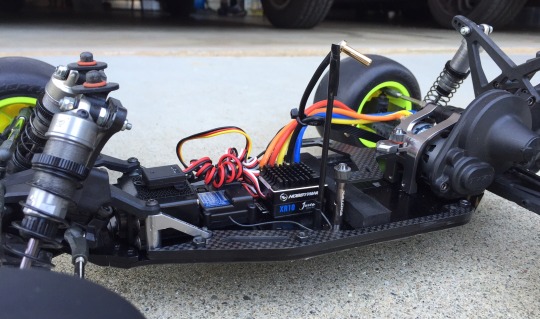
I had a chance to run the new Exotek chassis on my TLR 22T 2.0 for a few hours today. Got in 4 packs, and tried a few different things with it. Here are my first thoughts.
Weight
The Exotek chassis weighs a few grams more than the stock chassis, but is quite a bit more than the lightweight chassis. With lighter electronics, my car is actually 2 grams lighter than before and I made pretty much no setup changes to the car after swapping out the chassis. Oddly, the truck feels much heavier in my hands, even though it weighs about the same.
Weight distribution
The chassis makes the car feel very flat and low. The chassis itself is heavier than a stock chassis, but all of the weight is way down low and spread out. With a wider chassis to accommodate a transverse battery, the car feels a bit wider as well, which is a little hard to explain. A nice benefit of the chassis was that I was able to move my heavy ESC from above the battery in my old inline configuration onto the chassis in front of the battery. This gets the center of gravity even lower.
Jumping
The car also jumps much flatter, amazingly so, with less forward/aft pitch. I used to have a bit of a nose diving problem with an inline battery and the lightweight chassis, but this is pretty much cured.
Battery placement
With the transverse battery, you have about 15mm worth of fore/back battery placement and I tried the battery all the way front and all the way back. All the way back makes the car drive more like the inline option, and I ended up with that as my preference.
Forward battery placement places a lot of weight towards the middle of the car which helped in mid-high speed corners, but I had a harder time getting the car to rotate and it had very little fore/aft pitch on braking and acceleration. It felt a bit weird with a centralized mass bias in the middle of the car. On a more open track, this might work a bit better, but the local track is fairly tight with a lot of switchbacks, so I preferred the traditional battery back layout. I use about 10% drag brake, and with the rear battery it allowed me to plant the front end a little better on corner entry and move the rear around a bit.
It seems counter-intuitive that a rear battery would allow the car to rotate better and plant the front end, but it is basically allow more weight transfer under acceleration and braking. A forward battery keeps the chassis flatter with less weight transfer.
Stiffness
The chassis is very stiff and has little to no flex. I went from the lightweight chassis which had a fair amount of flex to the Exotek, and the Exotek seems to have no flex whatsoever. I don’t have an issue with grip, so the stiff chassis worked fine on a high grip surface.
Traction
Overall traction seems a little bit higher than before, and the car definitely does not roll as much as before. I may need to go up in springs or oil, there is still some minor tuning to be done.
Crashing
One interesting side effect of the low weight distribution is that the truck lands on its feet a lot more than before. Definitely an unexpected advantage to the chassis.
Bling factor
The black anodized and milled chassis with the carbon fiber bits make the car look very trick. Bling factor is super-high with this product!
Overall, I still need to play with the car some more and get a better feel for the truck. The general conclusion is the car drives lower and flatter than before, but at the expense of a bit of weight and cost.
No comments:
Post a Comment
Note: Only a member of this blog may post a comment.